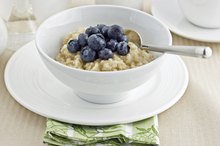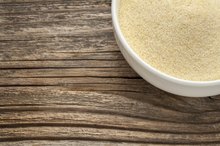What does fact checked mean?
At Healthfully, we strive to deliver objective content that is accurate and up-to-date. Our team periodically reviews articles in order to ensure content quality. The sources cited below consist of evidence from peer-reviewed journals, prominent medical organizations, academic associations, and government data.
- National Digestive Diseases Information Clearinghouse: Gas in the Digestive Tract
- National Digestive Diseases Information Clearinghouse: Celiac Disease
- MedlinePlus: Abdominal Bloating
The information contained on this site is for informational purposes only, and should not be used as a substitute for the advice of a professional health care provider. Please check with the appropriate physician regarding health questions and concerns. Although we strive to deliver accurate and up-to-date information, no guarantee to that effect is made.
Does Wheat Cause Bloating?
Feeling bloated is a common experience after eating, often due to overeating, eating too fast or consuming certain foods and drinks, such as carbonated sodas. Wheat also causes bloating in some individuals, the reasons often varying from person to person. If you find that bloating occurs consistently after eating wheat, consult a qualified health practitioner to determine the cause.
Intestinal Gas
Intestinal gas occurs as the result of swallowing excess air or bacteria in the intestines breaking down hard-to-digest foods. The pressure the gas exerts on the intestinal walls can create the feeling of tightness and distention commonly referred to as bloating. For some people, foods that contain carbohydrates -- including wheat -- can be hard to digest. This leads to gas and the accompanying symptoms, such as bloating, cramping, belching or passing gas. Bloating due solely to intestinal gas is usually temporary.
- Intestinal gas occurs as the result of swallowing excess air or bacteria in the intestines breaking down hard-to-digest foods.
- The pressure the gas exerts on the intestinal walls can create the feeling of tightness and distention commonly referred to as bloating.
Gluten Sensitivity
What Causes Foamy Diarrhea?
Learn More
Gluten is a generic name for proteins found in whole wheat, barley and rye. Some people have a hard time processing gluten in their digestive system, which can lead to symptoms of bloating, diarrhea, cramping, abdominal pain and constipation 2. Other symptoms not related to digestion can also occur, including depression and a "foggy" sensation in the head. More severe symptoms include anemia, joint pain, osteoporosis and leg numbness.
- Gluten is a generic name for proteins found in whole wheat, barley and rye.
- Other symptoms not related to digestion can also occur, including depression and a "foggy" sensation in the head.
Digestive Disorders
Many digestive disorders may include bloating as the sole symptom, at least in the initial stages. Celiac disease is most commonly associated with consuming wheat, as it is caused by an allergic reaction to gluten 4. Unlike gluten sensitivity, which only affects the digestive system, celiac disease involves the immune system 4. It can cause damage to the small intestine if left untreated. Other diseases such as irritable bowel syndrome and Crohn's disease can be exacerbated by eating wheat, leading to bloating.
- Many digestive disorders may include bloating as the sole symptom, at least in the initial stages.
- Other diseases such as irritable bowel syndrome and Crohn's disease can be exacerbated by eating wheat, leading to bloating.
Getting Treatment
Does Old-Fashioned Oatmeal Contain Gluten?
Learn More
Occasional bloating that occurs after eating wheat is often due to its hard-to-digest carbohydrates. Avoiding or limiting wheat consumption may help in that case. If, however, you consistently experience bloating after consuming wheat, or the bloating is accompanied by other symptoms, consult a doctor to determine the cause. A doctor may recommend a specific diet or medications to help you avoid future problems. Diseases such as celiac disease require avoiding wheat in any form, even in small amounts.
- Occasional bloating that occurs after eating wheat is often due to its hard-to-digest carbohydrates.
- If, however, you consistently experience bloating after consuming wheat, or the bloating is accompanied by other symptoms, consult a doctor to determine the cause.
Related Articles
References
- Center for Celiac Research and Treatment: Gluten Sensitivity FAQ
- MedlinePlus: Abdominal Bloating
- Ohio State University Wexner Medical Center: Digestive Disorders
- Celiac Disease Foundation: Gluten-Free Diet
- National Institute of Diabetes and Digestive and Kidney Diseases. Symptoms & causes of gas in the digestive tract. Updated July 2016.
- Sullivan SN. Functional abdominal bloating with distention. ISRN Gastroenterol. 2012;2012:721820. doi:10.5402/2012/721820
- American Addiction Centers. Alcoholic gastritis symptoms, causes & treatment. Updated Aug 6, 2020.
- National Institute of Diabetes and Digestive and Kidney Diseases. Eating, Diet, & Nutrition for Gas in the Digestive Tract. Updated July 2016.
- Cleveland Clinic. Gas: Care and treatment. Oct. 25, 2016.
- Harvard Health Publishing. Relief from intestinal gas. September 2013.
- Treatment for Gas in the Digestive Tract. National Institute of Diabetes and Digestive and Kidney Diseases.
- Foley A, Burgell R, Barrett JS, Gibson PR. Management strategies for abdominal bloating and distension. Gastroenterol Hepatol (N Y). 2014;10(9):561–571.
Writer Bio
Solomon Branch specializes in nutrition, health, acupuncture, herbal medicine and integrative medicine. He has a B.A. in English from George Mason University, as well as a master's degree in traditional Chinese medicine.









